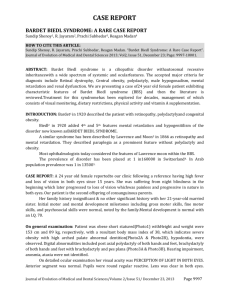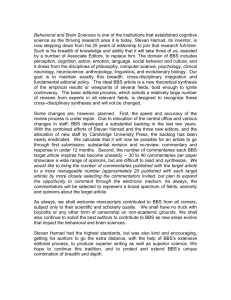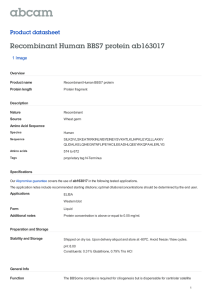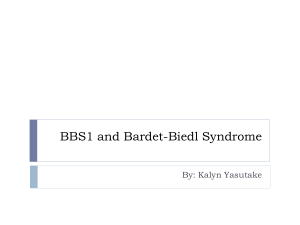Current Research Journal of Biological Sciences 4(4): 513-518, 2012 ISSN: 2041-0778
advertisement
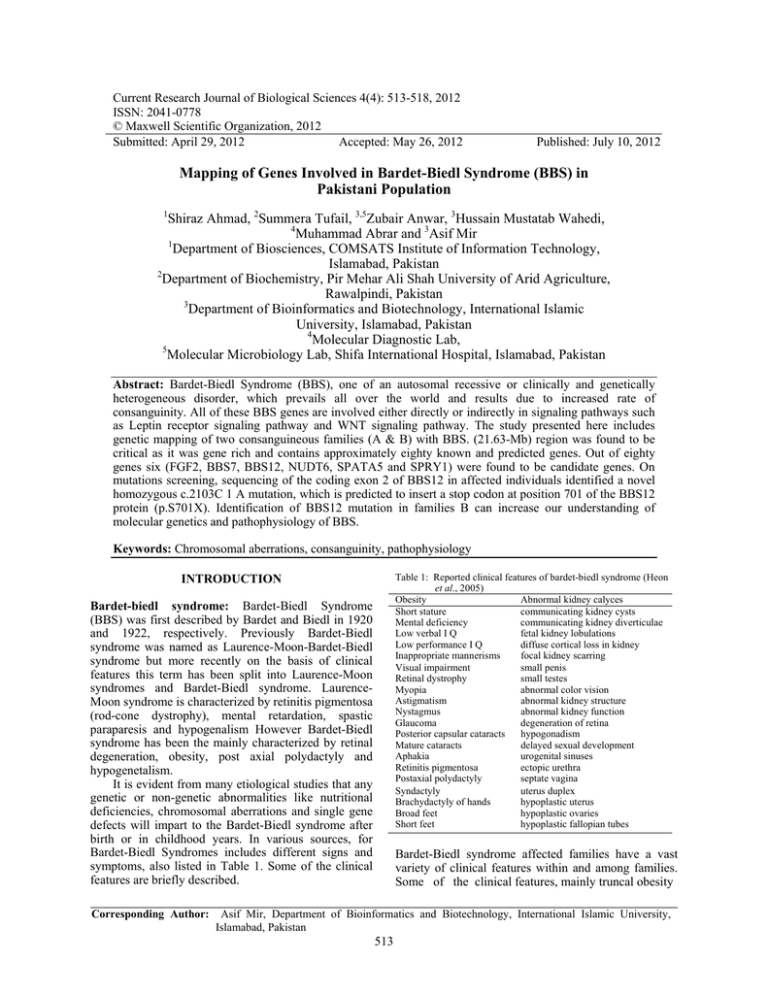
Current Research Journal of Biological Sciences 4(4): 513-518, 2012 ISSN: 2041-0778 © Maxwell Scientific Organization, 2012 Submitted: April 29, 2012 Accepted: May 26, 2012 Published: July 10, 2012 Mapping of Genes Involved in Bardet-Biedl Syndrome (BBS) in Pakistani Population 1 Shiraz Ahmad, 2Summera Tufail, 3,5Zubair Anwar, 3Hussain Mustatab Wahedi, 4 Muhammad Abrar and 3Asif Mir 1 Department of Biosciences, COMSATS Institute of Information Technology, Islamabad, Pakistan 2 Department of Biochemistry, Pir Mehar Ali Shah University of Arid Agriculture, Rawalpindi, Pakistan 3 Department of Bioinformatics and Biotechnology, International Islamic University, Islamabad, Pakistan 4 Molecular Diagnostic Lab, 5 Molecular Microbiology Lab, Shifa International Hospital, Islamabad, Pakistan Abstract: Bardet-Biedl Syndrome (BBS), one of an autosomal recessive or clinically and genetically heterogeneous disorder, which prevails all over the world and results due to increased rate of consanguinity. All of these BBS genes are involved either directly or indirectly in signaling pathways such as Leptin receptor signaling pathway and WNT signaling pathway. The study presented here includes genetic mapping of two consanguineous families (A & B) with BBS. (21.63-Mb) region was found to be critical as it was gene rich and contains approximately eighty known and predicted genes. Out of eighty genes six (FGF2, BBS7, BBS12, NUDT6, SPATA5 and SPRY1) were found to be candidate genes. On mutations screening, sequencing of the coding exon 2 of BBS12 in affected individuals identified a novel homozygous c.2103C 1 A mutation, which is predicted to insert a stop codon at position 701 of the BBS12 protein (p.S701X). Identification of BBS12 mutation in families B can increase our understanding of molecular genetics and pathophysiology of BBS. Keywords: Chromosomal aberrations, consanguinity, pathophysiology Table 1: Reported clinical features of bardet-biedl syndrome (Heon et al., 2005) Obesity Abnormal kidney calyces Short stature communicating kidney cysts Mental deficiency communicating kidney diverticulae Low verbal I Q fetal kidney lobulations Low performance I Q diffuse cortical loss in kidney Inappropriate mannerisms focal kidney scarring Visual impairment small penis Retinal dystrophy small testes Myopia abnormal color vision Astigmatism abnormal kidney structure Nystagmus abnormal kidney function Glaucoma degeneration of retina Posterior capsular cataracts hypogonadism Mature cataracts delayed sexual development Aphakia urogenital sinuses Retinitis pigmentosa ectopic urethra Postaxial polydactyly septate vagina Syndactyly uterus duplex Brachydactyly of hands hypoplastic uterus Broad feet hypoplastic ovaries Short feet hypoplastic fallopian tubes INTRODUCTION Bardet-biedl syndrome: Bardet-Biedl Syndrome (BBS) was first described by Bardet and Biedl in 1920 and 1922, respectively. Previously Bardet-Biedl syndrome was named as Laurence-Moon-Bardet-Biedl syndrome but more recently on the basis of clinical features this term has been split into Laurence-Moon syndromes and Bardet-Biedl syndrome. LaurenceMoon syndrome is characterized by retinitis pigmentosa (rod-cone dystrophy), mental retardation, spastic paraparesis and hypogenalism However Bardet-Biedl syndrome has been the mainly characterized by retinal degeneration, obesity, post axial polydactyly and hypogenetalism. It is evident from many etiological studies that any genetic or non-genetic abnormalities like nutritional deficiencies, chromosomal aberrations and single gene defects will impart to the Bardet-Biedl syndrome after birth or in childhood years. In various sources, for Bardet-Biedl Syndromes includes different signs and symptoms, also listed in Table 1. Some of the clinical features are briefly described. Corresponding Author: Bardet-Biedl syndrome affected families have a vast variety of clinical features within and among families. Some of the clinical features, mainly truncal obesity Asif Mir, Department of Bioinformatics and Biotechnology, International Islamic University, Islamabad, Pakistan 513 Curr. Res. J. Biol. Sci., 4(4): 513-518, 2012 Fig. 1: Reported BBS genes percentage in general population (Blacque et al., 2004) which is problematic throughout adulthood, learning problems; post taxial polydactyly, cone-rod dystrophy, child age vision loss which leads to night blindness, micropenis, renal dysfunction and complex female genital malformation are the causes of BBS. Throughout the world, BBS is prevailed with differential frequency rate because of a systemic disorder. Number of affected person of this syndrome is 1 in 150,000 individuals according to estimation. Geographic isolated races or high consanguinity populations have high rate of incidence. In Kuwait and new founded lands rate of BBS is 1: 13,500 and 1: 7,500 as compare to Europe and North America (1: 140,000 to 1: 160,000), respectively (Nicholas et al., 2001). Due to high consanguinity in the population of Bedouin and Arab tribes, rate of BBS is also high. Reported BBS genes percentages in general population are mentioned in Fig. 1. In our population, it is still question marked that why this incidence happened? Complete survey of affected families is required in Pakistan. Increase in incidence can effect on overall socioeconomic setup of development of Pakistan but it can be handled by the help of genetic counseling to reduce this syndrome. By our this study we can explore the genetics of BBS more keenly, which will be fruitfull for our coming generations. This will also affect positively to our country and an add up for the whole world, however a little bit but it will be fruitfull. MATERIALS AND METHODS This study was done in year 2009 to 2010 and all the wet lab processing was done in HMG lab, COMSATS institute of information technology, Islamabad, Pakistan. Two families A and B were collected, one from Azad Kashmir and another from Khyber Pakhtoon Khwa, for the current study. Family A and family B, both were indicating Bardet-Biedl Syndrome (BBS) disorder. Informed consents were obtained from all the family members who participated in the study. Both the families were visited at their places of residence to generate the pedigrees and collect the relevant information. The information obtained was crosschecked by interviewing different family members. The clinical examination was performed at the local hospital for both the families. All affected members of both the families were clinically examined including general physical examination, ophthalmological examination, X-rays of hands and feet and abdominal ultrasound. Patients of family B were referred to the hospital due to bilateral polydactyly and mild vision impairment. After a thorough discussion with elders of these families, genetic pedigrees were drawn according to standard method. The mode of inheritance of disorder was inferred by observing segregation of disease within family. Pedigree was constructed for each family by standard method described by Bennett et al. (1995). In the pedigree, males are symbolized by squares and females by circles. Filled circles and squares represent affected individuals, while normal individuals are represented with unfilled symbols. Deceased individuals are represented by a slanting line on the square or circle. Double lines in the pedigrees represent consanguineous marriages. The blood samples from both normal and affected individuals including their parents were collected by 10 514 Curr. Res. J. Biol. Sci., 4(4): 513-518, 2012 mL clean and sterilized syringes (0.7×40 mm 0.22 ×1½) (BD, USA) and from children below 2 years of age by butterflies, in standard potassium EDTA vacutainer tubes (BD, USA). The blood samples, collected in the field, were stored at 4°C in the laboratory, before being processed for extraction of genomic DNA. Genomic DNA was purified from blood collected in EDTA tubes according to already established Phenol extraction method (Organic Method) and then agarose gel electrophoresis was done. Genotyping was done by using standard method (as follows) using micro-satellite markers Micro-satellite markers were from the Marshfield maps and were obtained from Research. Genetics Inc. (USA). The cytogenetic locations of these markers, their heterozygosity as well as length of the amplified products were obtained from Genome Database homepage, Marshfield Medical Center and Rutger’s Map. After that Polymerase Chain Reaction was performed by the use of thermal cyclers provided by Perkin Elmer (Veriti system, Applied Biosystems, USA). For allele separation amplified PCR products were resolved on 8% non-denaturing poly-acrylamide gel. The gel was stained with ethidium bromide (100 mg/mL) solution and visualized on UV transilluminator. The alleles of the micro satellite markers were visualized by placing the ethidium bromide stained gel on UV transilluminator and documented with Gel, DOC-XR Gel Documentation system (Bio-Rad, UK) and analyzed with Quantity one (Bio-Rad, UK) soft ware package. Genetic databases were screened to select which genes and loci are already known to associate with Bardet-Biedl Syndrome (BBS) in Pakistani Population. Based on the results of these searches, both the families (A and B) were screened initially for linkage to known loci. Genotyping was carried out in families A and B with microsatellite markers associated with BBS loci. Selected markers had an average heterozygosity of >70%. After scoring the alleles for each marker, the segregation pattern of alleles of both normal and affected individuals was analyzed. To screen mutation in the BBS12 locus, the genes tested were FGF2, BBS7, BBS12, NUDT6, SPATA5 and SPRY. These genes were PCR amplified from genomic DNA. The purified PCR products were subjected to cycle sequencing using big dye terminator V 3.1 ready reaction mix and sequencing buffer (PE Applied Biosystems, Foster City, CA, USA). The sequencing products were purified to remove unincorporated nucleotide and primers with Centriflex TM Gel Filtration Cartridge (DGE Biosystems, Gaithersburg, MD, USA). These purified products were re-suspended in 10 uL of TSR (Template Suppression Reagent) and were placed in 0.5 mL septa tubes to be directly sequenced in an ABI Prism 310 Automated Sequencer (PE Applied Biosystems, Foster City, CA, USA). Chromatograms from normal and affected individuals were compared with the corresponding control gene sequences from NCBI (National Center of Biotechnology Information) database to identify the aberrant nucleotide base-pair change. RESULTS AND DISCUSSION Bardet-Biedl Syndrome is an autosomal recessive disorder prevailing all over the world and it results due to consanguinity that is the characteristics from the same lineage like another person having the same ancestor. So there are always greater chances of the occurrence of genetic disorder in the offspring having this kind of relationships. The most common features which are always under consideration during the diagnosis of BBS are congenital postaxial polydactyly including syndactyly and brachydactyly present in approximately 70% of cases and Retinitis Pigmentosa (RP) is found to occur in the early child hood. Moreover there are common renal abnormalities during the course of development. There is autosomal recessive disorder in the individual which are homozygous for specific gene mutation. It means that the individuals are carrier of gene with two similar alleles. But in few cases due to novel mutation, the parents of affected individual must be carrier of gene. Such parents are completely unaware of the truth that they are the carrier of defected gene as they don’t show any signs and symptoms of being carrier. We can say that the more is the degree of genetic correlation between the parents; more will be the risk of disease. But the risk is lower in the individual which have distant relationship like second cousin. It is obvious that there is large variability in the clinical and phenotypic features of Bardet Biedl syndrome. By using homozygosity mapping criteria, the recessive trait can be mapped through the offspring of the consanguineous mating. Because of genetic nature of the recessive inheritance, regions in close proximity of the disease causing locus are likely to be homozygous by descent in patients from the consanguineous families (Lander and Bostein, 1987; Sheffield et al., 1998). The homozygosity mapping is a 515 Curr. Res. J. Biol. Sci., 4(4): 513-518, 2012 I:1 II:3 I:2 II:1 III:1 II:2 II:4 III:2 IV:1 IV:2 III:3 IV:3 IV:4 IV:5 IV:6 IV:7 IV:8 IV:9 Fig. 2: Pedigree of family A with BBS. Circles represent females and squares show males. Filled squares and circles represent affected individuals, whereas double lines indicate consanguineous marriage I:1 II:1 I:2 II:2 II:3 II:4 Blood III:1 III:2 Blood IV:1 Blood IV:2 Blood IV:3 Blood IV:4 Blood IV:5 Blood IV:6 IV:7 Fig. 3: Pedigree of family B with BBS. Circles represent females and squares show males. Filled squares and circles represent affected individuals, whereas double lines indicate consanguineous marriage suitable method for fishing out disease causing gene in this disease. In order to establish a linkage, at least four affected sibling are required in first cousin marriage and only three affected siblings are required in the second cousin marriage. In family A mentioned in Fig. 2 six DNA samples (III: 2, IV: 1, IV: 2 IV: 3, IV: 4, IV: 6) including two normal and four affected individuals were selected for genotyping the markers linked to the candidate genes. In family B mentioned in Fig. 3, ten DNA samples, three BBS affected (IV: 2, IV: 3, IV: 9) four mentally retarded (IV: 1, IV: 5, IV: 6, IV: 8) and normal (III: 2, III: 3, IV: 4) were selected for genotyping the markers in the vicinity of known loci. Clinically, the affected 516 Curr. Res. J. Biol. Sci., 4(4): 513-518, 2012 Fig. 4: Schematic view of genome wide LOD score calculations for family B. The arrows indicate regions of maximum LOD scores of 1.83 (a) individuals showed polydactyly of hands and feet. These affected individuals also showed progressive night blindness which was mild in day time. It has been diagnosed through ophthalmological studies which have been carried out in Shifa Eye Trust Hospital in Rawalpindi that all the affected individuals have atypical Retinitis Pigmentosa (RP), myopia and astigmatism. However obesity and no renal abnormalities were observed in affected individuals. But physical examination showed hypodontia in all the affected individuals. Analysis of the results showed the linkage for BBS12 locus on 4q27 and identification of a novel BBS12 mutation. Genome-wide LOD score calculations resulted in maximum LOD scores of 1.83 mentioned in Fig. 4 at chromosomal region located on chromosome 4q27-4q31.22, respectively. In family B, 21.63-Mb region was found to be critical as it was gene rich and contains approximately eighty known and predicted genes. Out of eighty genes six (FGF2, BBS7, BBS12, NUDT6, SPATA5 and SPRY1) were found to be candidate genes. Mutation analysis of affected individuals resulted in the identification of novel mutation i.e., p.S701X. On mutations screening, sequencing of the coding exon 2 of BBS12 in affected individuals identified a novel homozygous c.2103C 1 A mutation mentined in Fig. 5, which is predicted to insert a stop codon at position 701 of the BBS12 protein (p.S701X). CONCLUSION (b) From the analysis of the results obtained with polymorphic micro-satellite markers specific for known BBS loci, it was evident that all the affected and normal individuals were homozygous for the different combinations. In family A, the linkage was established to BBS8 locus. Hence Identification of BBS12 mutation in family B can increase our understanding of molecular genetics and pathophysiology of BBS. By this continuous screening of more population we can go more deep in the root cause mutations and genes lying beneath this disorder to explore it more. REFERENCES (c) Fig. 5: Sequence chromatograms of c.2103C 1 A mutation in the index patient (IV-3), heterozygous carrier (III-2), and a healthy control of family B Bennett, R.L., K.A. Steinhaus, S.B. Uhrich, C.K. O'Sullivan, R.G. Resta, D. Lochner-Doyle, D.S. Markel, V. Vincent and J. Hamanishi, 1995. Recommendations for standardized human pedigree nomenclature. Am. J. Hum. Genet., 56: 745-752. 517 Curr. Res. J. Biol. Sci., 4(4): 513-518, 2012 Blacque, O.E., M.J. Reardon, C. Li, J. McCarthy, M.R. Mahjoub, S.J. Ansley, et al., 2004. Loss of C. elegans BBS-7 and BBS-8 protein function results in cilia defects and compromised intraflagellar transport. Genes Dev., 18: 1630-1642. Heon, E., C. Westall, R. Carmi, K. Elbedour, C. Panton, L. Mackeen, E.M. Stone and V.C. Sheffield, 2005. Ocular phenotypes of three genetic variants of Bardet-Biedl syndrome. Am. J. Med. Genet. A, 132: 283-287. Lander, E.S. and D. Botstein, 1987. Homozygosity mapping: A way to map human recessive traits with the DNA of inbred children. Science, 236: 1567-1570, DOI: 10.1126/science.2884728. Nicholas, K., J.R., Lupski and P.L. Beales, 2001. Exploring the Molecular basis of Bardet-Biedl syndrome. Hum. Mol. Genet., 20: 2293-2299. Sheffield, V.S., E.M. Stone and R. Carmi, 1998. Use of isolated inbred human populations for identification of disease genes. Trends Genet., 14: 391-396. 518
